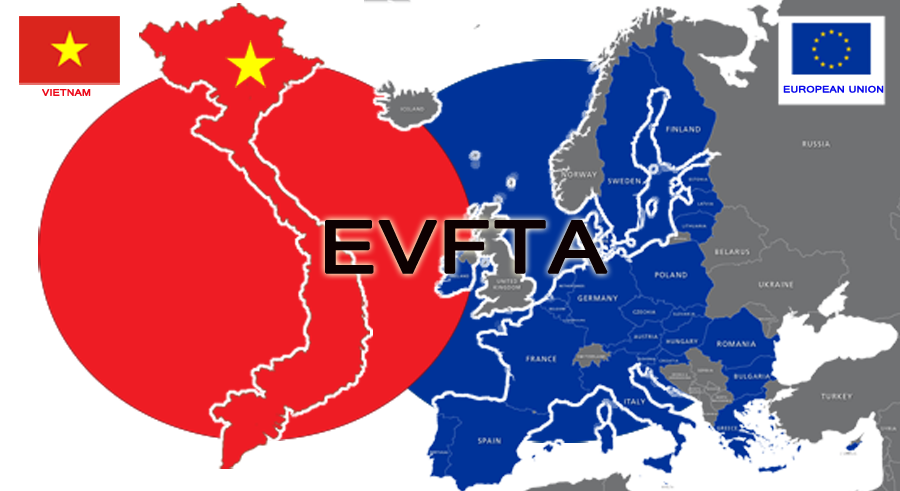The Vietnam - EU Free Trade Agreement (EVFTA) is a new generation FTA between Vietnam and the 28 EU member states.
The EVFTA Agreement officially took effect on August 1, 2020.
Do businesses find opportunities to develop and expand business after the free trade agreement between Vietnam and the European Union?
The EU-Vietnam Free Trage Agreement (EVFTA) was officially approved by the European Council on 30 March 2020 and approved by the
National Assembly of Vietnam. standard on June 8, 2020.
The EU is currently one of the leading trade partners of Vietnam with two-way turnover in 2019 reaching 56.45 billion USD, of which exports
reached 41.5 billion USD, imports from the EU reached 14.9 billion. USD. The EVFTA is a comprehensive, high-quality, and balanced agreement
of interests for both Vietnam and the EU, which also noted the difference in development levels between the two sides.
The implementation of the EU and Vietnam Free Trade Agreement (EVFTA) has created more motivation for sectors of the economy
to recover and develop to operate in a new normal state, industrial production in November / 2020 continues to flourish, especially the processing
and manufacturing industry with a high growth rate of 11.9% over the same period last year.
According to the General Statistics Office, the index of industrial production (IIP) in November 2020 is estimated to increase by 0.5% MoM and 9.2%
over the same period last year, of which the mining industry 6.2% reduction; processing and manufacturing increased 11.9%; electricity production
and distribution increased by 4%; water supply and waste and wastewater management and treatment increased by 5.3%.
Processing and manufacturing industry saw a high increase in November mainly due to the prosperity of industries: Coke production and refined petroleum
products increased by 125% (refined petroleum products increased by 131.1 %); metal production increased 39%; production of drugs, pharmaceutical chemistry
and medicinal materials by 19.1%; production of electronic products, computers and optical products by 18.9%; furniture production increased 15.8%; electrical
equipment manufacturing by 10.1%; machinery and equipment production not elsewhere classified by 9.4%; production of paper and paper products rose 8.8%.
Generally, in the first eleven months of 2020, the IIP was estimated to increase by 3.1% over the same period last year, lower than the 9.3% increase of the
same period in 2019. Of which, the manufacturing increased by 4.7%. (the same period in 2019 increased by 10.6%), contributing 3.8 percentage points to the
general growth; electricity production and distribution rose 3.2%, contributing 0.3 percentage points; water supply, waste and wastewater management and
treatment increased 4%, contributing 0.1 percentage points; the mining industry alone decreased by 7.1%, down 1.1 percentage points in the overall growth.
Among secondary industries, a number of key industries had a sharp decrease or a very low increase in the 11-month production index compared to the same period
last year: Mining and ore supporting services decreased by 33.5%; crude oil and natural gas exploitation decreased by 11.8%; motorbike and motorcycle production
down 10.3%; repair, maintenance and installation of machines and equipment down 9.1%; engine vehicle production by 8.9%; wood processing and wood, bamboo and
cork products down 6.8%; beverage production by 5.5%; clothing production decreased by 4.5%; drainage and wastewater treatment decreased by 3.2%; leather and
related products by 2.5%; production of other non-metal mineral products by 1.5%; electrical equipment manufacturing rose 2.3%; production and distribution of
electricity, gas, hot water, steam and air conditioning rose 3.2%.
In addition, a number of industries with 11-month production index increased significantly compared to the same period last year: Manufacturing medicine,
pharmaceutical chemistry and medicinal materials increased 29.2%; metal production by 13.6%; metal ore mining increased 13.4%; production of coke coal and
refined petroleum products by 11.5%; manufacturing of electronic products, computers and optical products by 10.2%; exploitation of hard coal and lignite
increased by 7.8%; production of beds, wardrobes, tables and chairs up 7.6%; production of chemicals and chemical products, and production of paper and paper
products rose 7.5%.
Some key industrial products in 11 months decreased deeply or increased low compared to the same period last year: Diameter decreased by 21.7%; LPG down 13.9%;
beer decreased by 13.8%; crude oil exploitation decreased by 13.5%; natural gas in the form of gas decreased by 10.4%; fabrics made of man-made fibers decreased
9.4%; motorbike down 8.2%; cars by 7.5%; casual clothes down 5.3%; shoes and leather sandals by 2.5%.
Besides, a number of major industrial products increased significantly compared to the same period last year: Television increased 23.6%; phone components rose 15.7%;
rolled steel increased by 13.4%; steel bars and angle steel increased by 11.6%; powdered milk increased 9.4%; gasoline of all kinds increased by 8.9%; urea increased
by 8.5%; clean coal and monosodium glutamate rose 7.8%; fabrics made of natural fibers rose 6.3%.
The number of employees working in industrial enterprises as of November 1, 2020 increased 1.1% from the same period last month and decreased by 2.4% from the same period
last year, of which State-owned enterprises decreased by 1.8%; non-state enterprises decreased by 3.9%; enterprises with foreign investment decreased by 1.8%.
At that time, the number of employees working in mining enterprises decreased by 1.5% compared to the same period last year; processing and manufacturing decreased by 2.5%;
electricity production and distribution decreased by 0.3%; water supply, waste and wastewater management and treatment decreased 0.6%.
